
Project Overview
This was a concept project where I was one of 3 designers who designed the solutions for OzHarvest to archive the target of reducing food waste.
A recent report shows that Australia is the tenth most wasteful country in the world with more than 7.6 million tonnes of food waste each year. A third of food waste is from our homes and tackling food waste at home is the single most impactful action each of us can do. OzHarvest wants to explore if technology could play the role in helping people to get into the habits of saving household food waste.
How might we create an easy and engaging way for people to be proactively involved in saving food waste activities?
TYPE
Concept project
DURATION
2 weeks
MY ROLE
UX/UI Design
TOOLS
Figma, Figjam, Zoom, Google Form
Design process & methods

Challenges & Problems
How we could effectively remind the public about new habits that will benefit themselves, those around them, and the environment
What are the ways we could reward their users for being proactive and for changing their habits
What strategies we could implement to motivate individuals to become more actively involved in supporting the mission
Solutions
A native application to help people get into the habit of only purchasing what they need and using it up before it goes bad
Combining with the handy shopping list feature and inventory tracking system to help people track, organise and manage food stock at home
A rewarding system that encourages people to continue taking action of reducing food waste
Discovery
Why there is huge food waste
To understand why there is huge food waste in our homes and what makes people throw out food, we created survey questions and conducted user interviews to get insights into people’s food shopping, cooking and stocking habits and what could motivate people to develop new habits.
Insights from survey questions
The survey results show us that most people check food stock before shopping, but they forget to check sometimes. A lot of people use shopping lists, but they still overbuy food for some reasons. These are the potential causes of household food waste.
Only 1/10 of people always remember to check food stock before shopping
9/10 people always or sometimes use shopping lists for food shopping
All people have overbought food in some cases
People throw out food when it is expired or has gone bad
What did users say?
Key insights from the interviews
“
I want to track food storage and maybe have a reminder to help day to day organising
”
“
I always over purchase as I can buy impulsively when there is a deal
”
“
I don’t always keep track of expiry dates. I find out when it’s been sitting there for a while or doesn’t look right
”
“
I am usually organised, but hope to do list within one app. Don’t like to switch between apps
”
Archetypes
From the surveys and interviews, we were able to identify two main types of users, the organised planner and the spontaneous buyer. The organised planner is someone who likes to plan ahead and keep track of food usage while the spontaneous buyer tends to act on impulse and often over buy food.

The planner likes to be organised when it comes to shopping and cooking. They check stock and make a list before shopping to make sure they only purchase what they need. Sometimes, they feel guilty because they have to throw out food that has expired or looks visually bad when checking stock. They feel bored with making the same meal plan every week and lack the inspiration to use up all ingredients.
Goals:
- Only shop for what’s needed
- Keep track of use by/expiry dates
- Find more interesting dishes to cook
Habits:
- Go shopping at least once a week
- Check food stock, make meal plans and lists for shopping
- Will throw food that is expired or visually bad
Pain points:
- Get overwhelmed with the amount of food that piles up
- Lose the track of expiry dates or leftover
- Feel bored with eating the same dishes

The spontaneous like the thought of making a grocery shopping list but often forget to. They have an idea of what he would like to cook and purchase in bulk because they don’t know how to proportion ingredients. They also buy things that attract their eyes or are on sale as they are not prepared for shopping.
Goals:
- Get organised for food shopping and cooking
- Stop over-purchasing and cooking
- A clear view of what stock they have
Habits:
- Go shopping blindly, make their mind up as they go
- Buy extra food on sale/clearance
- Often do impulsive shopping
Pain points:
- Get frustrated when they see double-ups of food
- Feel overwhelmed seeing too much food
- Have to throw out a lot of food
Which behaviours matter?
There is a secondary research that conducted by the organisation. The Impact-Likelihood Matrix visually compares the different behaviours based on their impact, likelihood and opportunity for uptake.
Shopping, storage and cooking practices have the largest range of potential behaviours to reduce food waste in Australian homes.
Making a shopping list has already been adopted as they are relatively easy and commonly used
Subscribing to a meal kit or recipe box service has a high impact yet to be adopted by many consumers
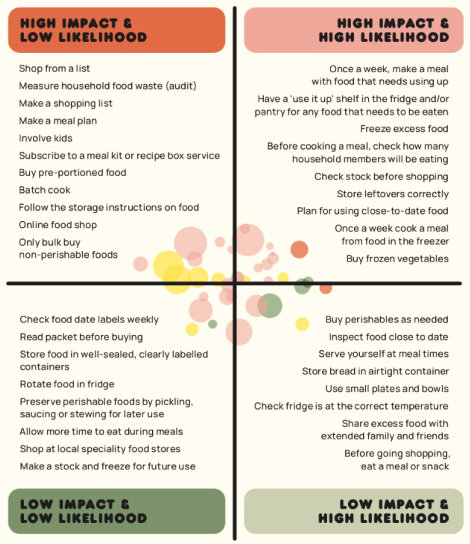
Having a ‘use it up’ shelf in the fridge or pantry has low uptake but the greater opportunity for adoption
Making it easier for consumers to organise food storage at home would increase uptake.
Key features for the MVP
Our proposal is that we believe that creating a native application could be a potential solution to changing behaviours in reducing household food waste. We took into consideration all our research paired with our target users and identified the most important features.
MUST HAVE
- Handy shopping list connected with food stock and recipe ideas
- Inventory tracking system with auto expire date
- Donation motivation
- Rewarding system - keep behaviors
SHOULD HAVE
- Share achievements
- Modify expiry dates
COULD HAVE
- Barcode and QR code scanner
- Prompt for duplicate items
- Collaboration cloud
WON’T HAVE
- Barcode and QR code scanner
- Prompt for duplicate items
- Collaboration cloud
Inspiration & Ideation
Inspirations from comparators
Fridge Hero - Connect the shopping list with the inventory system, and users are able to add expiry dates to food items
RecipeCloud - Interactive recipe feature that can add and save ingredients
Use it up tape - The use it up tape is a visual reminder to use food that is set to expire.
Apple Reminders - Uses key archivement feature as motivation to encourage people to continue on saving food
The solution
Key features of the mobile app
Shopping list feature which connected with the inventory management system
The adjustable recipe feature encourages people to use it up
The rewarding system helps people engage in daily food saving activities
The prototype
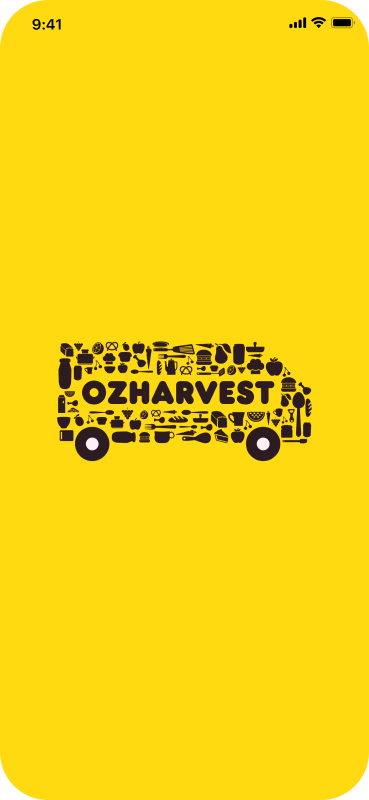
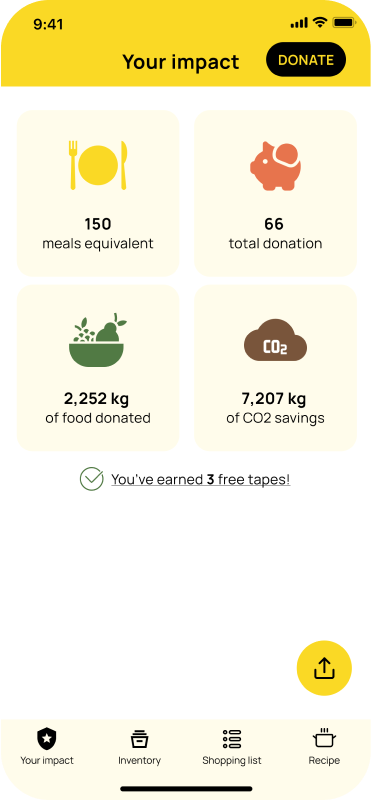
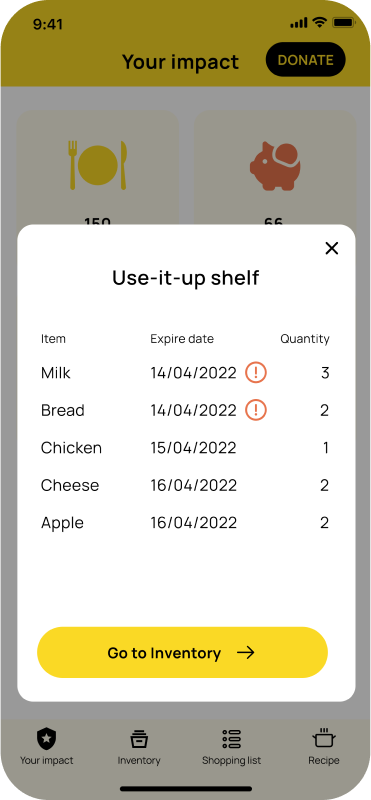

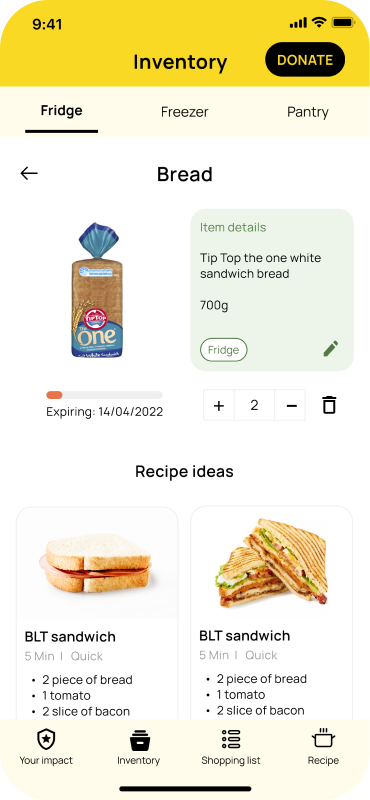
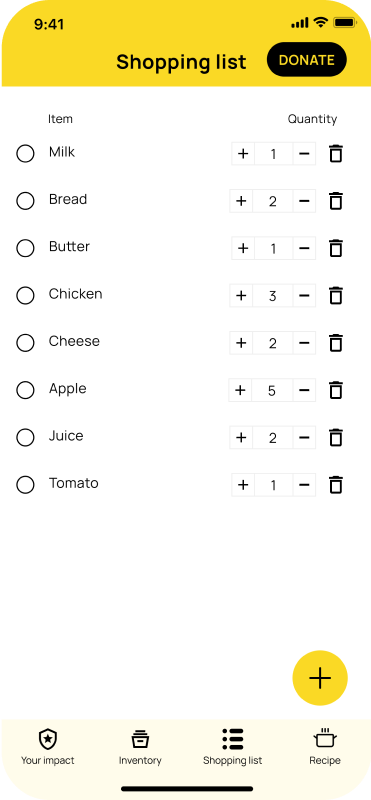
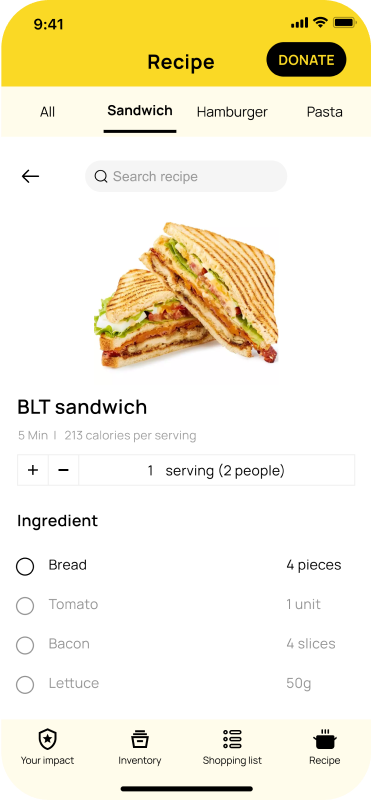
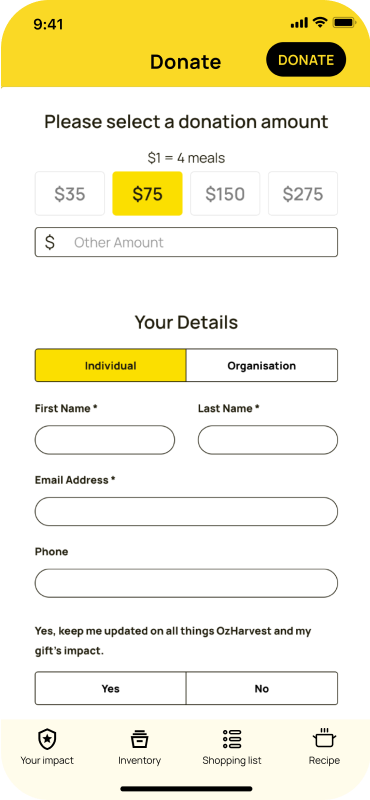
Reflection
Dr.BJ Fogg’s philosophy and model of behaviour change which explains that three elements must converge simultaneously for a behaviour to occur. When a behavior does not occur, one of these three elements is missing.
The more features you have at launch the harder it is to tell what works and what doesn’t. It is great to explore broader with solution but make sure it is scalable. Prioritise features in order to create the Minimum Viable Product is important.
Effective teamwork achieves much more than any individual can. Understanding team members’ work personalities can help identify the best approach for achieving the team goal.

